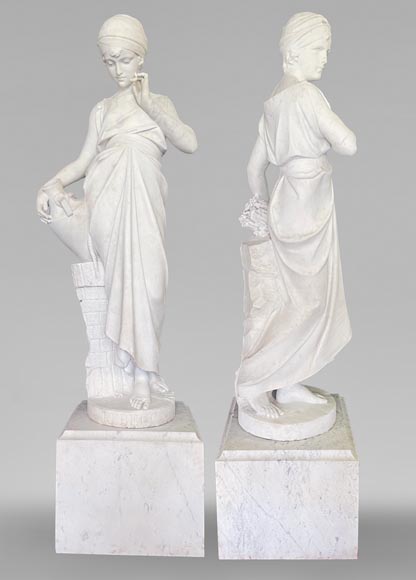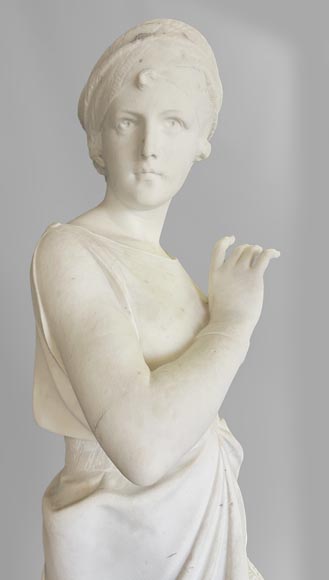Style romanticism / Ref.12083
Paul Berthier, Rebecca and Ruth, early 20th century
Dimensions
Width 20'' ⅞ 53cm
Height 58'' ⅝ 149cm
Depth: 20'' ½ 52cm
Origin:
Early 20th century.
Status:
Contact us for condition report
These two sculptures in marble were made by Paul Berthier in the early 20th century.
Paul Berthier (1879-1916) was a pupil of two sculptors, Antonin Mercié and Victor Peter. He exhibited at the 1903 and 1904 Salons and received an honourable mention in 1904. His work is part of the Orientalism movement, with figures from the Maghreb and the Middle East, and animals representative of the fauna of these countries.
The first of these two statues depicts a young woman standing by a well, holding a jug in her hand; she is dressed in a drape with light embroidery incised into the collar and lower fringe, and wearing a turban. Her name, Rebecca, is inscribed on the base. The second statue features a young woman dressed in the same way and carrying a sheaf of wheat at her side; the inscription refers to her as Ruth. The two statues correspond in their postures: Rebekah's hand is raised towards her lowered face, while Ruth's head is raised and she is looking straight ahead. Both are depicted in contrapposto.
The names of the two young women refer to two biblical characters from the Old Testament: Rebecca is Isaac's wife, while Ruth is Boaz's wife. The first appears in the Genesis: Abraham sends his servant to find a wife for his son Isaac. He tells him that he will find her drawing water, and that he will recognise her because she will give him something to drink. The sculptor depicts the young woman as she is described in the Bible, dressed simply, with a few jewels. The full jug symbolises her intact virginity, and her lowered face refers to her modesty and shyness.
The story of Ruth is told in the book that bears her name. Originally from the kingdom of Moab, Ruth marries Noemiah's son; now a widow, she moves to Bethlehem with her mother-in-law. At harvest time, they both glean ears of wheat from a field belonging to Boaz. Ruth is shown meeting Boaz, holding the ears of wheat she has just gathered in her left hand and trying to hide them with her right. Berthier sculpted two women from the Bible as they meet their future husbands.
These iconographic themes can also be found in the work of other artists. In 1855, Pierre Antoine Hippolyte Bonnardel sculpted Ruth Gleaning (now in the Louvre), a statue of the young woman in action. In 1866, Giovanni Maria Benzoni created a veiled Rebecca, now in the Salar Jung Museum in India.
Both statues bear witness to the influence of Orientalism on Berthier's work. However, the models for these two figures are clearly characterised by a European canon of beauty, as was often the case at the time. This oriental influence is reminiscent of that exerted on the art of Eugène Delacroix, whose female figures may also be turbaned and wrapped in a wide drape marked at the waist, as in Portrait of a Woman Wearing a Blue Turban or Greece on the Ruins of Missolonghi.
Berthier's statues were therefore in keeping with the times, and with his contemporaries' pronounced taste for representations inspired by travel or accounts of journeys to the South or East. Like other artists, he did not have the opportunity to travel to these lands in person, but this did not prevent him from depicting a dreamlike, fantasised elsewhere.
Informations
Price: on request
Recommended for you :
Dimensions:
Width: 149
Height: 82
Depth: 48
Dimensions:
Width: 26
Height: 77
Depth: 38
Dimensions:
Width: 66
Height: 159
Depth: 64
Dimensions:
Width: 86
Height: 194
Depth: 44
Diameter: 44
Dimensions:
Width: 110
Height: 137
Depth: 82
Dimensions:
Height: 117
Diameter: 135
Dimensions:
Width: 60
Height: 172
Depth: 57
Dimensions:
Width: 107
Height: 224
Depth: 121
Dimensions:
Width: 220
Height: 70
Depth: 90
Dimensions:
Width: 68
Height: 194
Depth: 56
Dimensions:
Width: 100
Height: 100
Depth: 53
Dimensions:
Height: 238
Diameter: 75


































